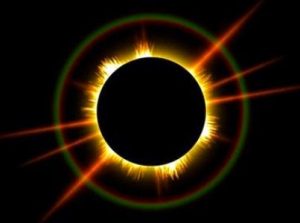Total Eclipse of the Heart and Mind By John Patrick Lestrade, Ph.D.
During our January meeting for NOSHA, member John Patrick Lestrade, Ph.D., did a reading that we’d like to share for everyone who couldn’t attend that day.
Some of you may have never experienced a lunar eclipse. During this event, when the Moon finds itself in presumably total blackness behind the Earth, the Moon can still be visible to us. It shines with a deep red color. The first question is “Why is there light shining on it?”
***
You may have noticed that the Sun and the Moon appear to be the same size in the sky. Of course, the Sun is much larger than the Moon – almost a million miles wide for the Sun versus only 2,000+ miles across for the Moon. But the Sun doesn’t appear larger because it is much farther away. What’s interesting is that although the Sun is about 400 times wider than the Moon, it is also 400 times farther away. Thus both appear to be the same size!
So, during a Solar eclipse, when the Moon blocks out the Sun for the lucky few in the path of totality, the lunar and solar disks match up almost exactly. This leads to especially beautiful solar eclipses, where the Moon blocks the bright disk of the Sun but leaves the outer, very hot corona visible. Sometimes there are beads of sunlight that filter through the mountains on the lunar perimeter.
So think about this: Is the fact that our Moon is just the right size and distance from us a coincidence or can it have a deeper meaning for us? Remember that the Moon causes tides on the Earth. Evolutionary biologists will tell you the importance of tides and tidal pools in our evolution. So perhaps it is not just a coincidence that we have a Moon of the right size and distance relative to our star. Perhaps without it we wouldn’t be here to enjoy these celestial displays.

